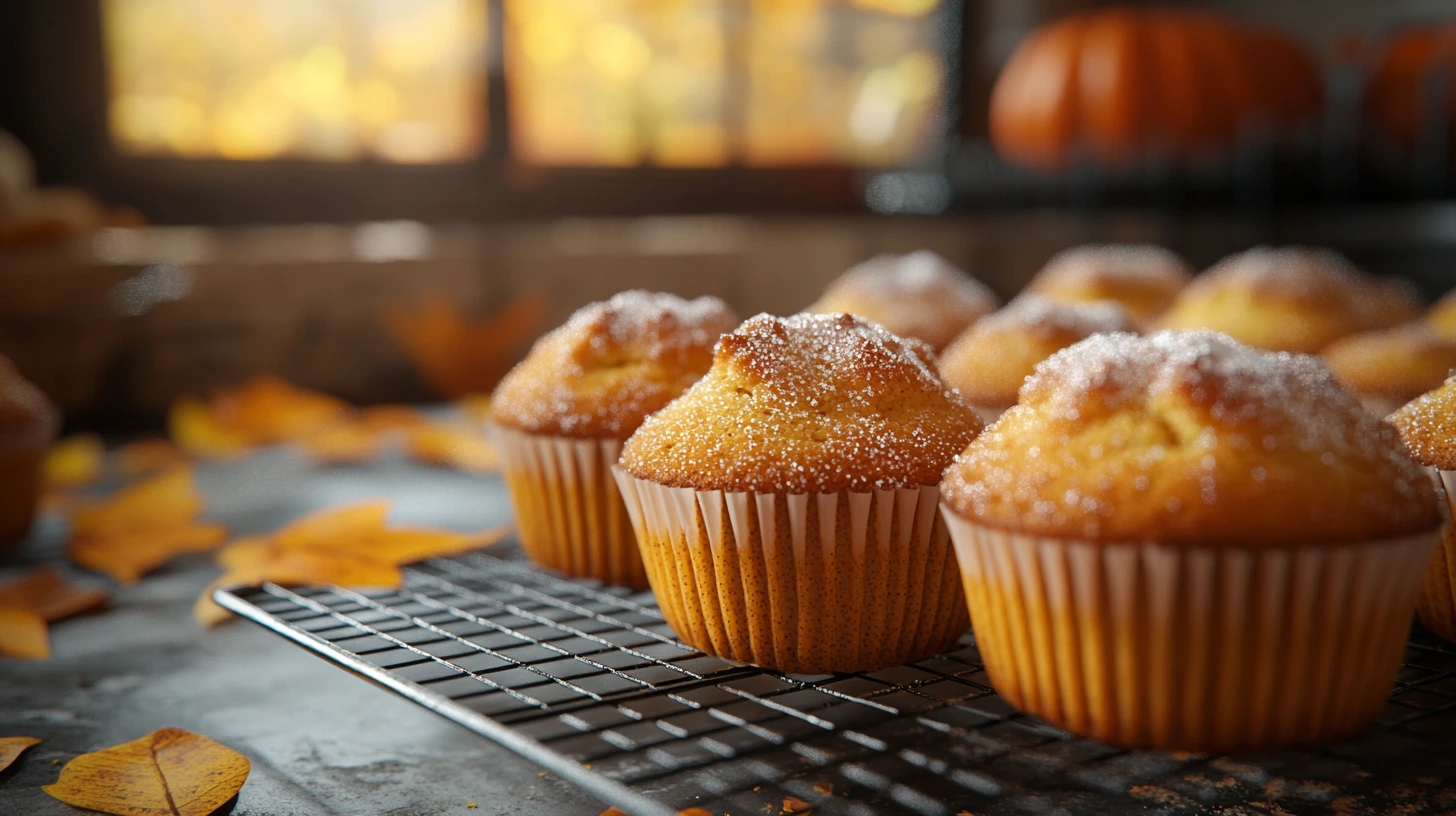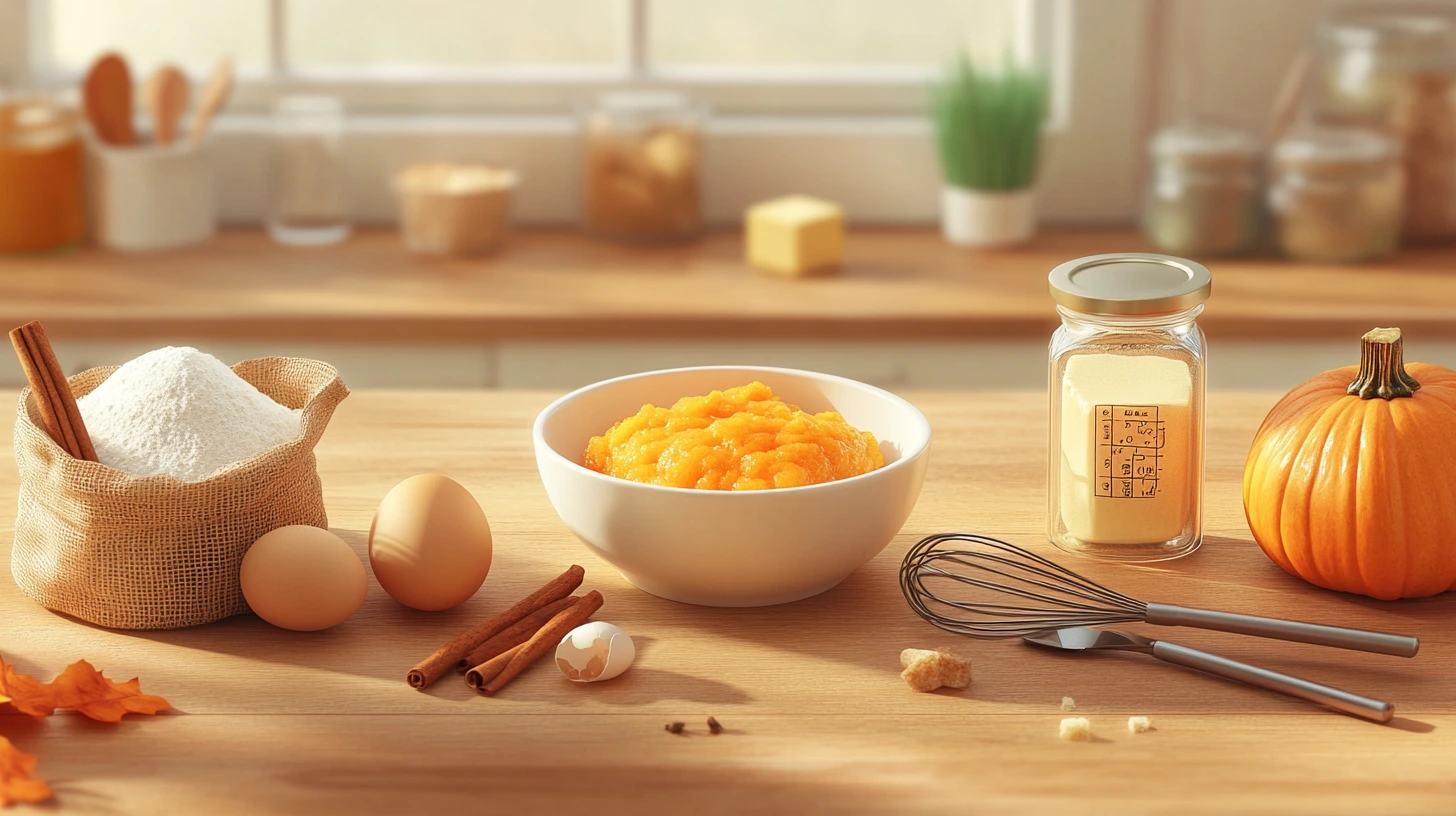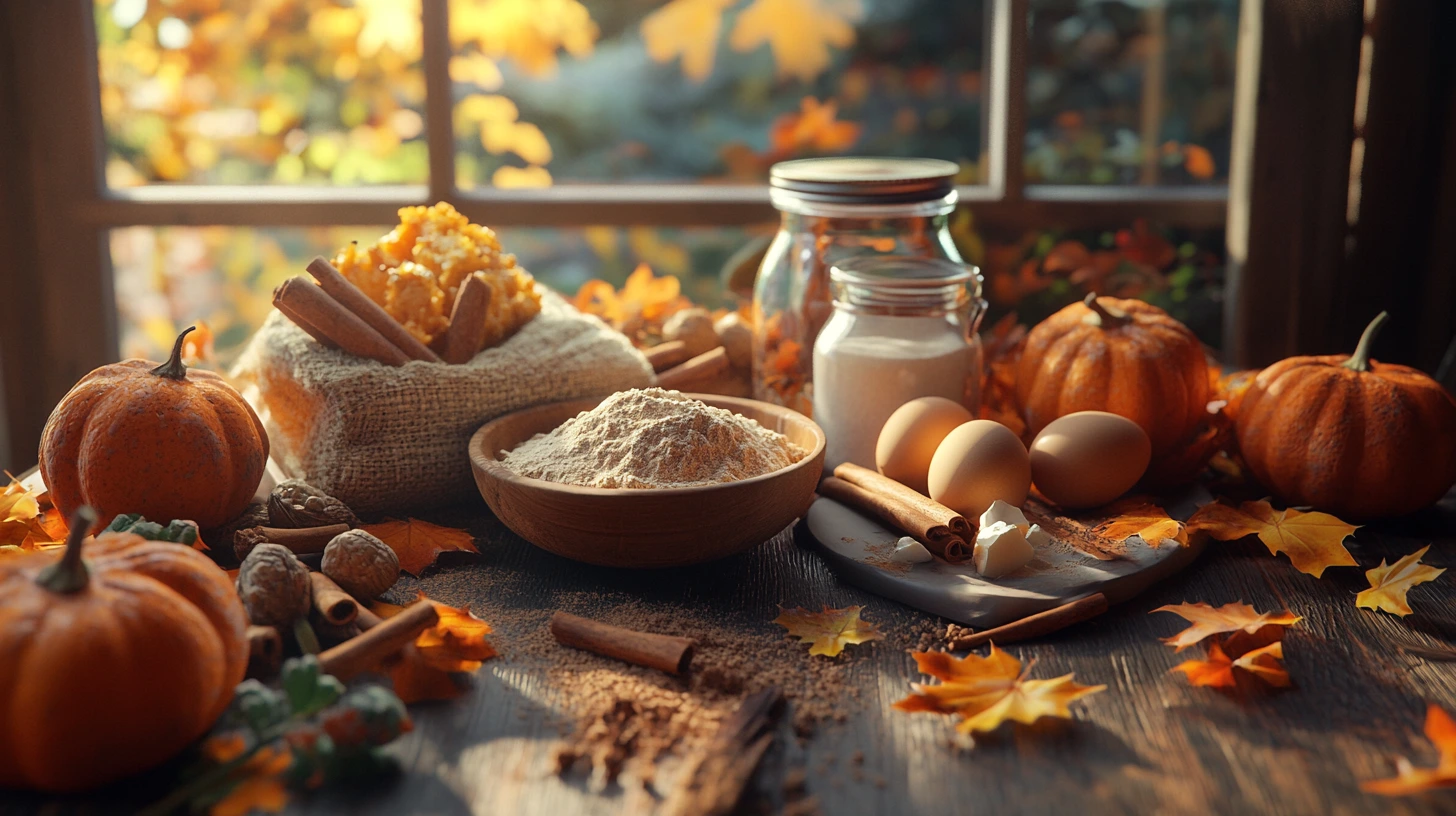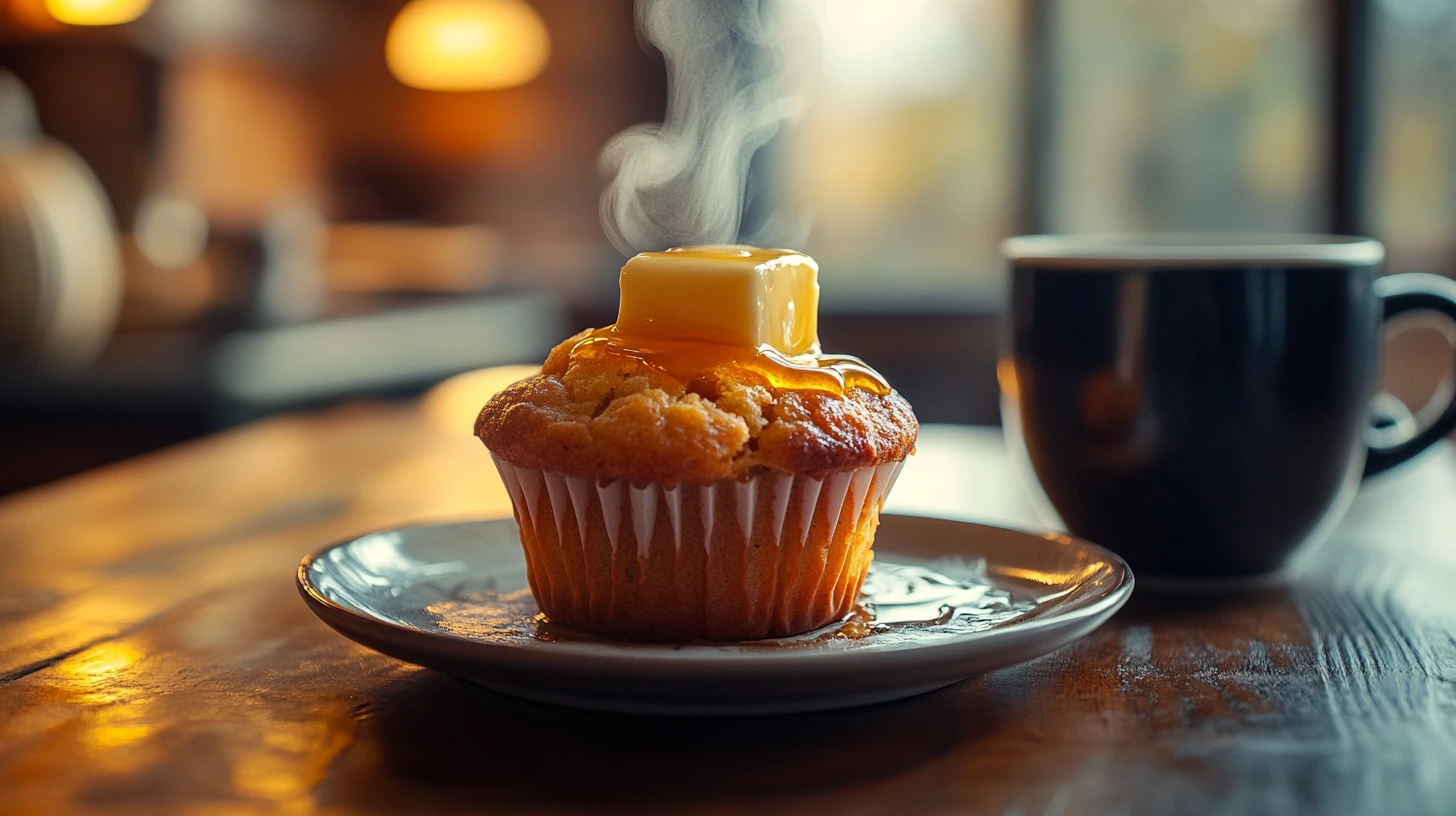
Table of Contents
Introduction to Pumpkin Muffins
What Makes Pumpkin Muffins Special?
Pumpkin muffins recipe are beloved for their moist texture, warm spices, and rich, earthy flavor. The key ingredient, pumpkin puree, imparts natural sweetness and keeps the muffins tender and moist. Combined with aromatic spices like cinnamon, nutmeg, and cloves, these muffins offer a comforting taste that feels like a cozy embrace. Their versatility allows endless variations, from classic recipes to those studded with nuts, chocolate chips, or cream cheese swirls.
Seasonal Appeal of Pumpkin Muffin Recipe
Pumpkin muffins are synonymous with fall, a season celebrated for its vibrant colors and cozy flavors. As pumpkins become abundant in autumn, these muffins become popular for showcasing the season’s bounty. They evoke the comforting essence of fall holidays like Halloween and Thanksgiving, making them a nostalgic and much-anticipated treat.
Beyond fall, canned pumpkin ensures that these muffins can be enjoyed year-round, but they carry a unique charm during the colder months when their warm flavors feel most fitting.
Why They’re Perfect for Any Occasion
- Breakfast and Snacks:
- Pumpkin muffins are satisfying and portable for busy mornings or midday energy boosts.
- Pair them with coffee, tea, or a warm latte for a perfectly balanced treat.
- Festive Celebrations:
- Their seasonal flavors make them a hit at holiday gatherings, potlucks, or as a Thanksgiving dessert alternative.
- Customizable Recipes:
- With gluten-free, vegan, or sugar-free variations, pumpkin muffins can accommodate diverse dietary needs and ensure that everyone loves them.
- Homemade Gifting:
- These muffins are an ideal homemade holiday gift, bringing warmth and joy to friends and family.
Ingredients for Pumpkin Muffin Recipe

Key Ingredients for Flavor and Texture
- Pumpkin Puree:
- Pumpkin puree, the recipe’s star, provides a rich, earthy flavor and moistens the muffins. It also adds a subtle natural sweetness and a beautiful orange hue.
- Flour:
- All-purpose flour is commonly used, but whole wheat or gluten-free flour can be substituted for a healthier or dietary-friendly option.
- Spices:
- A blend of warm spices, such as cinnamon, nutmeg, ginger, and cloves, is essential for achieving the classic pumpkin muffin flavor.
- Pre-made pumpkin pie spice can be used for convenience.
- Sweeteners:
- Brown sugar adds depth and hints of molasses, while granulated sugar provides balance. Natural sweeteners like honey or maple syrup can also be used.
- Eggs:
- Eggs provide structure and help bind the ingredients. For vegan options, flax eggs or applesauce can be substituted.
- Oil or Butter:
- Oil (such as vegetable, coconut, or olive) keeps the muffins tender and moist. Melted butter can also be used for a richer flavor.
- Leavening Agents:
- Baking soda and baking powder ensure the muffins rise and have a light, fluffy texture.
- Add-Ins (Optional):
- For added flavor and texture, enhance the muffins with chocolate chips, chopped nuts, dried cranberries, or a cream cheese swirl.
Using Canned vs. Fresh Pumpkin Puree
- Canned Pumpkin Puree:
- Convenience: Canned pumpkin is pre-cooked, pureed, and ready to use, making it a time-saving option.
- Consistency: It has a smooth, uniform texture and consistent moisture content, ensuring reliable results.
- Availability: It’s easy to find year-round and popular for most recipes.
- Note: Be sure to use pure pumpkin puree, not pumpkin pie filling containing added sugar and spices.
- Fresh Pumpkin Puree:
- Flavor: Fresh puree can have a slightly lighter and more delicate flavor than canned.
- Process: Make fresh puree, roast, or steam pumpkin flesh, then blend until smooth. Strain it to remove excess water for a thicker consistency.
- Seasonality: This option is perfect during the fall when pumpkins are abundant.
- Which to Choose?:
- For convenience and consistency, canned pumpkin is ideal for most home bakers.
- If you enjoy the process of using fresh, in-season ingredients or want to customize the texture, fresh pumpkin is a rewarding alternative.
Preparing the Pumpkin Mixture
How to Make Smooth Pumpkin Puree
- Using Fresh Pumpkin:
- Select the Right Pumpkin: Choose a sugar pumpkin or pie pumpkin for the best flavor and texture. Avoid using large carving pumpkins, as they can be stringy and watery.
- Roasting Method:
- Cut the pumpkin in half and scoop out the seeds.
- Place the halves cut-side down on a baking sheet lined with parchment paper.
- Roast at 375°F (190°C) for 45–60 minutes or until the flesh is tender.
- Scoop out the cooked flesh and let it cool.
- Blending:
- Blend the roasted flesh in a food processor or blender until smooth.
- If the puree is watery, strain it through a cheesecloth or fine mesh sieve to remove excess moisture.
- Using Canned Pumpkin:
- Open a can of pure pumpkin puree and stir it to ensure a smooth consistency.
- If needed, blend or whisk the puree to remove any lumps.
- Key Tip:
- For fresh and canned puree, ensure it’s at room temperature before mixing it into the batter for a consistent texture.
Adjusting Sweetness and Spice Levels
- Sweetness:
- Start with the Base: Follow the recipe’s suggested amount of sugar or sweetener.
- Adjust as Needed:
- If using naturally sweet pumpkins, you may reduce the sugar slightly.
- Use substitutes like honey, maple syrup, or stevia for less sweet muffins.
- Add sweetness with mix-ins like raisins or chopped dates if desired.
- Spice Levels:
- Classic Balance: Stick to the traditional pumpkin spice blend of cinnamon, nutmeg, ginger, and cloves. Adjust proportions to suit your taste:
- For a bolder flavor, increase cinnamon or nutmeg.
- For a milder spice, reduce cloves and ginger.
- Customize:
- Add cardamom for an exotic twist or a pinch of cayenne for a subtle kick.
- Test and Tweak:
- Mix the spices separately and taste a pinch with some puree to find your preferred balance before adding them to the batter.
Step-by-Step Pumpkin Muffin Recipe

Mixing Dry Ingredients
- Prepare Your Ingredients:
- Measure out all dry ingredients to ensure accuracy.
- Combine the Dry Ingredients:
- In a large mixing bowl, whisk together:
- One ¾ cup (220 g) of all-purpose flour (or whole wheat flour for a healthier option)
- 1 tsp baking soda
- 1 tsp baking powder
- ½ tsp salt
- 2 tsp ground cinnamon
- ½ tsp nutmeg
- ¼ tsp ground ginger
- ¼ tsp ground cloves (optional)
- Whisking ensures the spices are evenly distributed and helps aerate the flour for a lighter batter.
- Optional Add-Ins:
- At this stage, mix in any dry add-ins, such as chopped nuts, raisins, or chocolate chips, to prevent them from sinking into the batter.
Combining Wet Ingredients
- Prepare the Pumpkin Mixture:
- In a separate bowl, combine:
- 1 cup (240 g) pumpkin puree (canned or fresh)
- ⅔ cup (130 g) brown sugar
- ⅓ cup (80 ml) granulated sugar (or a natural sweetener like honey or maple syrup)
- ½ cup (120 ml) vegetable oil (or melted butter for a richer flavor)
- Two large eggs (room temperature)
- 1 tsp vanilla extract
- Mix thoroughly using a whisk or hand mixer until smooth and creamy.
- Key Tip:
- Ensure all wet ingredients are at room temperature to create a uniform batter and prevent curdling.
Folding the Batter for a Fluffy Texture
- Combine Dry and Wet Ingredients:
- Make a well in the center of the dry ingredients and pour the wet mixture into it.
- Gently fold the ingredients together using a spatula or wooden spoon. Avoid overmixing, as this can make the muffins dense.
- Achieve a Smooth Batter:
- Mix until just combined. It’s okay if a few streaks of flour remain; they will be incorporated during baking.
- Add Final Touches:
- If desired, fold in wet add-ins like fresh fruit chunks or a cream cheese swirl carefully to maintain the batter’s lightness.
- Portion the Batter:
- Divide the batter evenly into a lined or greased muffin tin, filling each cup about ¾ full.
Baking and Finishing
- Bake:
- Preheat the oven to 375°F (190°C) and bake for 18–22 minutes, or until a toothpick inserted into the center of a muffin comes out clean.
- Cool:
- Allow the muffins to cool in the pan for 5 minutes, then transfer to a wire rack to cool completely.
Baking Perfect Pumpkin Muffin Recipe
Setting the Oven Temperature
- Preheat the Oven:
- Preheat your oven to 375°F (190°C) before placing the muffins inside. A properly preheated oven ensures even baking and helps the muffins rise.
- Choose the Right Temperature:
- Most pumpkin muffin recipes call for 350°F to 375°F. The slightly higher temperature of 375°F allows the muffins to rise quickly, creating a domed top.
- Position the Rack:
- Place your muffin tin on the center rack for even heat distribution. Avoid placing it too close to the top or bottom of the oven, which can cause uneven baking.
- Adjust for Convection Ovens:
- If using a convection oven, lower the temperature by 25°F and reduce baking time slightly to prevent overbrowning.
How to Avoid Overbaking or Underbaking
- Know the Baking Time:
- Pumpkin muffins typically bake for 18–22 minutes, depending on their size. Watch closely during the last few minutes to prevent overbaking.
- Test for Doneness:
- Insert a toothpick or skewer into the center of a muffin:
- They’re done if it comes out clean or with a few moist crumbs.
- If there’s wet batter on the toothpick, bake for 2–3 more minutes and test again.
- Watch for Visual Cues:
- The muffins should have a golden-brown top and spring back lightly when touched. The edges may slightly pull away from the liner.
- Prevent Overbaking:
- Remove the muffins from the oven as soon as they are done. Leaving them in too long can cause them to dry out.
- Avoid Underbaking:
- If your muffins seem underbaked despite proper timing, check your oven temperature with an oven thermometer. Oven temperature can vary, and calibrating it can help achieve consistent results.
- Cooling Matters:
- Let the muffins cool in the pan for 5 minutes to finish setting before transferring them to a wire rack. Removing them too early can cause them to collapse.
Healthy Variations of Pumpkin Muffin Recipe

Gluten-Free Pumpkin Muffins
- Substitute the Flour:
- Use a gluten-free all-purpose flour blend that includes xanthan gum for structure.
- Alternatively, combine gluten-free flours like almond, oat, or coconut flour. Use 1 ¾ cups total, adjusting for consistency.
- Bind the Batter:
- Add 1 tablespoon of ground flaxseed or psyllium husk to help bind the ingredients, as gluten-free flours lack the elasticity of regular flour.
- Moisture Balancing:
- Gluten-free batters can be drier, so slightly increase the amount of pumpkin puree or oil.
- Tips:
- Let the batter rest for 5–10 minutes before baking to allow the flour to hydrate and the texture to improve.
Vegan and Dairy-Free Alternatives
- Egg Substitutes:
- Replace each egg with:
- 1 tablespoon ground flaxseed + 3 tablespoons water (flax egg)
- ¼ cup unsweetened applesauce
- ¼ cup mashed banana (adds sweetness and flavor)
- Dairy-Free Milk:
- Substitute regular milk with plant-based options like almond, soy, oat, or coconut.
- Butter Alternatives:
- Replace butter with coconut oil, vegetable oil, or a vegan butter substitute.
- Vegan Sweeteners:
- Use maple syrup, agave nectar, or coconut sugar for plant-based sweetness.
Reducing Sugar and Fat Content
- Reduce Sugar:
- Use natural sweeteners like honey, maple syrup, or date puree instead of granulated sugar.
- Cut the sugar amount in half and rely on the natural sweetness of the pumpkin and spices.
- Lower the Fat:
- Half or all of the oil can be replaced with unsweetened applesauce or mashed bananas for a moist texture without added fat.
- Greek yogurt (or a dairy-free alternative) is another excellent low-fat option for replacing oil.
- Enhance Flavor Without Sugar:
- Increase spices like cinnamon, nutmeg, and vanilla extract to compensate for reduced sweetness.
- Add Fiber:
- Mix ingredients like oat bran, ground flaxseed, or chia seeds for added nutrients and texture.
Additional Tips for Healthier Muffins
- Portion Control: Use a mini muffin tin for smaller servings.
- Boost Protein: Add a scoop of protein powder or mix in nuts like walnuts or pecans.
- Avoid Overmixing: This keeps the muffins tender and prevents a dense texture, especially with healthier substitutions.
FAQs About Pumpkin Muffin Recipe
Can I Use Pumpkin Pie Filling Instead of Pumpkin Puree?
- No, pumpkin pie filling is not a substitute for pumpkin puree.
- Pumpkin Puree: Pure pumpkin with no added ingredients. It’s the ideal base for pumpkin muffins, allowing you to control the sweetness and spice.
- Pumpkin Pie Filling: Pre-sweetened and pre-spiced, designed for making pumpkin pies. Using it in muffins may result in overly sweet muffins with unbalanced flavors.
- Alternative: If you only have pumpkin pie filling, reduce the sugar and spices in the recipe, but results may vary.
How Long Do Pumpkin Muffins Stay Fresh?
- At Room Temperature:
- Store in an airtight container for up to 2–3 days. Add a paper towel inside to absorb moisture and prevent sogginess.
- In the Refrigerator:
- Refrigerate for up to 1 week in a sealed container. Allow the muffins to return to room temperature or warm them slightly before serving for the best texture.
- In the Freezer:
- Pumpkin muffins freeze well. Wrap them individually in plastic wrap or store them in a freezer-safe bag for up to 3 months.
- To reheat, thaw at room temperature or microwave for 20–30 seconds.
What’s the Secret to Fluffy Muffins?
- Don’t Overmix:
- Overmixing the batter develops gluten, leading to dense muffins. Stir the wet and dry ingredients together gently until just combined.
- Use Room-Temperature Ingredients:
- Ensure eggs, milk, and pumpkin puree are at room temperature. This creates a smoother batter that incorporates air more effectively.
- Leavening Agents:
- Use the right amounts of baking powder and baking soda for proper rise. Check that your leavening agents are fresh and not expired.
- Fill the Muffin Cups:
- Fill each muffin cup about ¾ full to help the muffins rise properly and create a domed top.
- Bake at the Right Temperature:
- Start baking at 375°F (190°C) for a quick rise. Avoid opening the oven door during baking, as it can cause the muffins to deflate.
Conclusion
Pumpkin muffin recipe are a delightful treat that perfectly balances flavor, texture, and seasonal charm. Whether you’re a seasoned baker or trying them for the first time, their versatility allows you to create recipes tailored to your taste and dietary needs. From classic versions to healthier alternatives, these muffins are as comforting as they are easy to prepare.
You can enjoy pumpkin muffins year-round by understanding key ingredients, mastering baking techniques, and exploring creative variations. Whether served as a cozy breakfast, a festive dessert, or a thoughtful gift, these muffins celebrate warmth and togetherness.
Try this recipe tonight and tag us @biscsweet on social media and follow us on Facebook.
